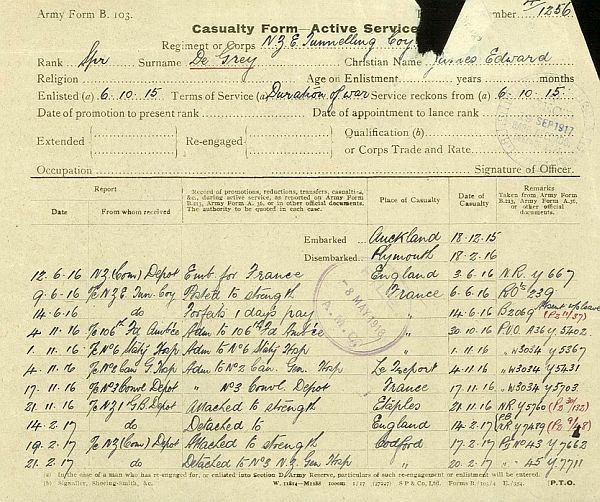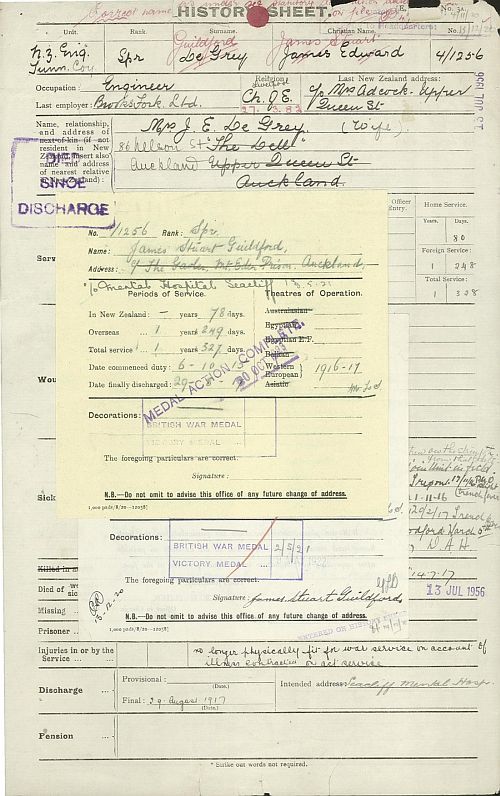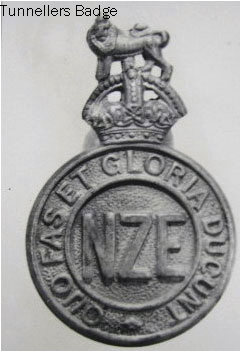|
WW1 - James Edward De Grey
NAME James Edward De Grey SERVICE NO WWI 4/1256, Engineer
Evening Post, 28 Sept 1915; WELLINGTON CITY'S QUOTA MEN BEING CALLED-UP: The following men are being called up as the contribution of Wellington City and Suburbs to the new battalions (3rd and 4th Battalions Trentham, Rifle Brigade) going into camp on the 12th prox. : Infantry - J S Guilford
Auckland Hospital and Charital Aids Board - Application for relief: Married; Occ; Domestic Duties; Address 38 St Benedicts St. off Newton Rd.; Husband James Stuart Guildford (confined to goal 21 yrs) Father Hector J Alcock St Benedicts St. and sister (Dargaville) Relatives able to contribute for relief. (Divorce - 1920 Archives: Sapper JE. de Grey, alias JS Guilford, 4/1256; April 1917 to Feb 1920. Embarked WW1 Vessel Ruapehu with NZ Engineers Tunnelling Company. SRC: New Zealand Tunnelling Company also Wikipedia Recruited in New Zealand in 1915, the men of the Tunnelling Company arrived in France in March 1916 under the command of 33-year-old regular soldier and Boer War veteran Major J.E. Duigan. The first New Zealanders to reach the Western Front, they were a so-called non-divisional unit – not part of the New Zealand Division, which arrived from Egypt the following month.Most of the tunnellers were quarrymen, gold miners from Waihi and Karangahake, or labourers from the Railways and Public Works departments. Others were coal miners from the West Coast of the South Island, but these workers were generally discouraged from enlisting due to the essential nature of their industry. The hardbitten tunnellers gave Duigan some disciplinary headaches. Both the Allies and the Germans were trying to tunnel under each other’s lines to lay mines, so underground experience was invaluable. At first, they were involved in successful efforts to foil German mining – known as counter-mining operations – just to the north-east of Arras. In November 1916 the tunnellers moved to Arras itself. Over the next five months they worked at connecting and extending the two existing underground systems and creating new tunnels. They helped construct a complex system of galleries, subways, kitchens, headquarters and hospitals – facilities capable of comfortably housing at least 12,000 men at any one time. With a major Allied push planned for April 1917, the tunnellers shifted to a more offensive role early in the year. They tunnelled towards the enemy lines from inside the cavern system and laid three mines under German trenches for detonation when the attack began. Tunnels were also driven to positions just short of the German trenches to assist communication as the attack developed. However, some of these efforts were negated by the February pull back of Germans in part of the sector, following the sudden abandonment by the Germans of the Somme battlefield and withdrawal to the Hindenburg Line. During the advance of 9 April the cavern system proved briefly useful in one small part of the attack front. One of the fourteen BEF divisions involved was able to pass through it to emerge in no man’s land near the enemy line. But the rapid advance of up to 5 kms along the whole front soon left the system well in the rear. The Germans eventually brought the advance to a halt, though not before the Canadian Corps seized the tactically important Vimy Ridge. As with most Western Front battles, this victory was achieved at a great cost in lives, with more than 3500 Canadians being killed and a further 7000 wounded. Following the April 1917 offensive, the tunnellers were deployed on a number of tasks in the vicinity of Arras. During the winter of 1917–18 they returned to the cavern system to refurbish it for possible use when the Germans launched their anticipated spring offensive. James discharge unfit - his Service - 17 Dec 1915 to Discharge 29 Aug 1917 
During Operation Mars, on 28 March 1918, the tunnellers occupied a reserve trench to bolster the defences, but in the event were not needed as the main defences held firm. The Tunnelling Company finally left the Arras area in July 1918. During the Hundred Days Offensive the tunnellers built bridges in the same sector in which the New Zealand Division was serving. By the end of the war they had suffered at least 62 deaths and many more non-fatal casualties in the course of their overseas service. The tunnels were closed after the Second World War and not rediscovered until 1990. |


 Enlisted
as Sapper James Edward de Grey b: Liverpool March 27, 1882, [a.k.a. GUILDFORD, James Stuart] WWI
4/1256, April 1917 - February 1920 NZ Engineers Tunnelling Co. WW2 Reg No 1
819156;
Enlisted
as Sapper James Edward de Grey b: Liverpool March 27, 1882, [a.k.a. GUILDFORD, James Stuart] WWI
4/1256, April 1917 - February 1920 NZ Engineers Tunnelling Co. WW2 Reg No 1
819156;